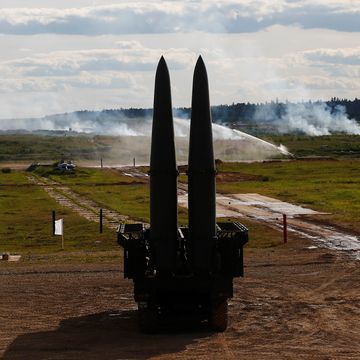- A U.S. Air Force gunship sank a simulated fishing boat during Exercise Balikatan 2024.
- The exercise took place in the Philippines, where China is using paramilitary fishing boats to force its territorial claims.
- The destruction was part of a SINKEX that saw the AC-130 train its guns on the target ship.
A U.S. Air Force gunship shredded a fishing boat as part of joint exercises between the United States and the Philippines. While sinking a simulated civilian vessel seems in poor taste, China is using ships just like it—which have been known to carry weapons—to bully other countries. The exercise was a clear sign to the Chinese government that aggression, even by innocent-looking fishing boats, would be repelled in all forms.
“Shoulder to Shoulder”
The exercises, known as Balikatan (“Shoulder to Shoulder” in the Filipino national language, Tagalog) have run from April 22 until today, May 8, and take place in the Philippines. The exercise, known as Balikatan 2024, is meant to reinforce defense cooperation between the two countries, but also includes participating contingents from the Australian Defence Forces and the French Navy.
Balikatan 2024 involves the deployment of 11,000 soldiers, sailors, Marines, and airmen to the Philippines for exercises involving “maritime security, sensing, and targeting, air and missile defense, dynamic missile strikes, cyber defense, and information operations”.
Ghostrider SINKEX
Among the many events in the annual exercise was the participation of an AC-130J Ghostrider gunship from the 27th Special Operations Wing, based at Hurlburt Field, Florida. The AC-130J, based on the C-130J Super Hercules, is the latest in a long line of transport aircraft converted into gunships that goes as far back as the Vietnam War.
The Air Force operates 37 of them at this time, each armed with a 30-milimeter side-firing chain gun and a direct-fire, 105mm howitzer. The gunship can also attack enemy forces with the Griffin air-to-ground missile, launched from tubes in the side of the aircraft.
The result is a versatile platform that can attack targets in direct-fire mode, loitering over the battlefield and raining shells down on enemy positions, typically in support of conventional or special operations forces. The platform’s vulnerability to guns and missiles, however, restricts it to operating in “permissive” airspace, or airspace without advanced enemy air defenses. Even against lightly armed adversaries, it typically operates at 10,000 feet or higher, staying out of range of short-range, shoulder-fired, surface-to-air missiles.
Unlike previous generations of gunships, the Ghostriders can still engage enemy forces from a distance. New to the Air Force’s gunships are wing-mounted pylons capable of carrying air-to-ground munitions, including Hellfire missiles and GBU-39 Small Diameter Bombs (SDBs). SDBs, launched from high altitude and then gliding toward their target with the help of GPS and small, pop-out wings, can strike targets up to 40 miles away.
Maritime Militia
In this month’s exercise, an unused fishing boat was procured by the Armed Forces of the Philippines and parked off the coast of Lubang Island, on the western edge of the Philippine archipelago. In what is called a SINKEX, or “Sinking Exercise,” an AC-130J circled above it, firing down into the ship and quickly sinking it.
Most of the hits appeared to come from the gunship’s GAU-23/A 30mm chain gun, although one towering explosion and shower of water, at the 10-second mark, appeared to come from a 105mm howitzer. The hull of the ship quickly disappears beneath the waves, leaving only the twin masts above the surface.
The destruction of a fishing boat, ostensibly a strictly civilian vessel, was not an exercise in bad judgment, but a pointed demonstration to the Chinese government.
In the 2010s, China began asserting its claim to the so-called “Nine Dash Line,” a line consisting of nine dashes that demarcated its territorial claims in the South China Sea. That wasn’t all that unusual, but the scope of the claims, including virtually 90 percent of the sea, was more atypical. The territorial claim also ignored competing claims from China’s neighbors, including Indonesia, Malaysia, Taiwan, the Philippines, Vietnam, and Brunei.
China’s claim in the South China Sea is so expansive it reaches more than 500 miles from the Chinese mainland to within 50 miles of the Philippines. The Philippines disputes this, and ships of the two countries have repeatedly faced off in the sea. Chinese Coast Guard ships have aggressively used water cannons and ramming tactics against otherwise peaceful Filipino ships, breaking windows and injuring crew members.
One tool used by China in the disputes is the so-called “maritime militia,” or China’s extremely large commercial fishing fleet. Under China’s militia system, fishing boats in private hands can be called upon to undertake paramilitary missions, including surveillance and intelligence gathering missions. They are also used to outnumber and intimidate ships from opposing countries, and have been used against ships of the Philippines.
According to the Center for Naval Analyses, the ships also receive training in direct action missions, including “anti-air missile defense, light weapons use, and sabotage operations.” All of this makes them a deniable asset for the Chinese government, one that can carry out violence, intimidation, and other unneighborly acts at sea without being an official part of government.
The use of a fishing boat as a target was not ill-conceived, or the result of getting the cheapest floating piece of scrap possible to act as a target. It was deliberate, and sends a message to China that the fishing boats of the Maritime Militia won’t be spared if they are used for violent action simply because they’re civilian hulls. If they carry weapons into combat and act as naval auxiliaries, they’re fair game.
As a large, slow-moving, converted transport aircraft, the AC-130J’s usefulness in a major conflict has been called into question. The gunship may not have a chance against a Chinese carrier battle group, or an island-based, surface-to-air missile system. But if any aircraft has the patience to loiter for hours over a fleet of fishing boats, and then pick the armed ships and engage them with precision fire, it’s the Ghostrider.
The Maritime Militia may have met its match.

Kyle Mizokami is a writer on defense and security issues and has been at Popular Mechanics since 2015. If it involves explosions or projectiles, he's generally in favor of it. Kyle’s articles have appeared at The Daily Beast, U.S. Naval Institute News, The Diplomat, Foreign Policy, Combat Aircraft Monthly, VICE News, and others. He lives in San Francisco.


















